previous name: Charles M. Everest (1933)
Home Port: Wilmington, DE
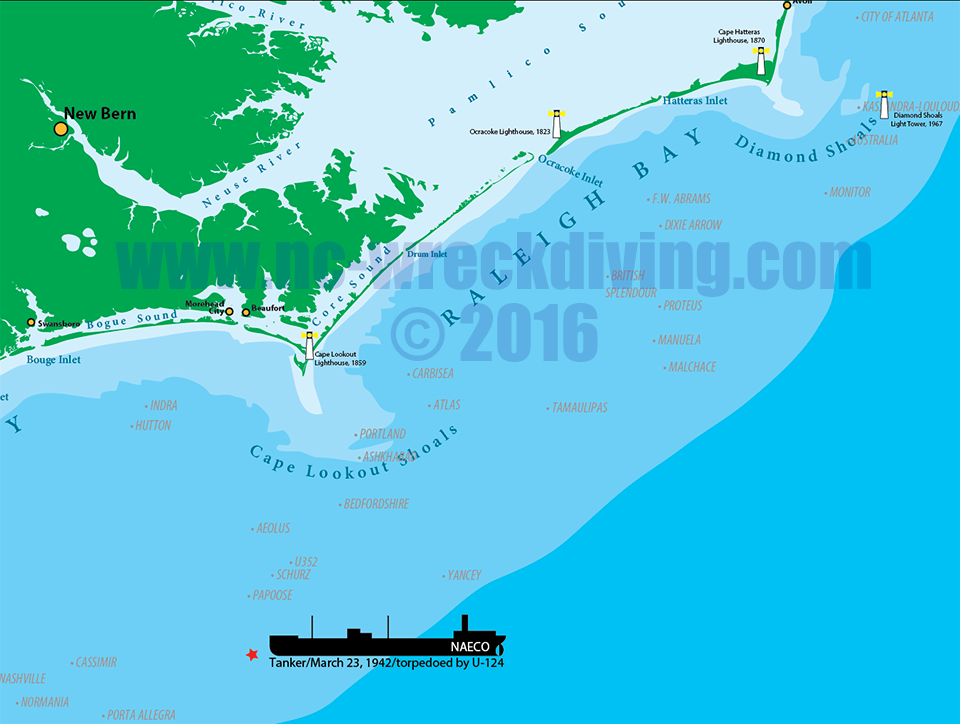

Naeco (Moore)
| SHIP NOTES: (Sources: Jordan, Gentile) | |
| Name: NAECO previous name: Charles M. Everest (1933) |
Type: Tanker |
| Built: 1918 by Bethlehem Shipbuilding Corporation, Wilmington, DE | Owner: Charles Kurz & Co., Inc., Philadelphia, PA Home Port: Wilmington, DE |
| Size (ft.): 428-0 x 53-5 x 25-7 | Gross Tonnage: 5373 tons |
| Propulsion: Single screw reciprocating steam engine/speed 10 knts | |
| Date Sunk: 3/23/1942 | Cause: Torpedoed by U-124 |
| Location Cape Lookout, NC | GPS: N34° 01.520'/W76° 38.878' (stern) |
|
|
|
 |
|
 |
|
|
Naeco (Moore)
|
|
| SHIP HISTORY: (Sources: Moore, Hickam, Gentile, Wynn) |
| Captained by Emil H. Englbrecht, the Naeco was making its way from Houston, TX with 97,000 barrels of #2 fuel oil. The tanker was traveling alone and unarmed towards its final destination of Seawaren, NJ. Early on the morning of March 23, the Naeco was 65 miles SE of Cape Lookout, NC and unbeknownst to the captain and crew, it was already under attack. KL Johann Mohr and the U-124 had been off the NC coast for only 10 days, but had already wrecked havoc by sinking or damaging the Ceiba, Acme, Kassandra Louloudis, E.M. Clark, Papoose, W.E. Hutton, Esso Nashville and Atlantic Sun. The u-boat now had the Naeco in its periscope. The first torpedo missed or was a dud. Unaware, the tanker steamed onward. At 0315 a second torpedo found its mark, hitting the Naeco on the starboard side near the midship house with catostrophic results. The explosion immediately ignited the fuel oil and engulfed the deck house and bridge and spread burning fuel over the water. All hands in the bridge area and forward were killed in the explosion or by the resulting flames. Over 20 miles away, the USCGC Dione got word of the attack and rushed to assist. It was still miles away when it could see the volcanic eruptions and burning plume from the Naeco in the night sky. The Dione crew braced itself for what it would find at the attack site. Back on the tanker, chaos reigned and it soon became apparent that the ship was doomed. It was abandoned at 0445. All of the forward lifeboats were destroyed in the fire. The first lifeboat launched swamped as the tanker was still making headway when lifeboat hit the water. Finally, the #3 boat was succesfully launched with 10 crew members. The tanker continued to burn and eventually broke in two. The bow sank first. The stern continued to float and burn until it sank around 0830. The Dione arrived on the scene at 0730 and picked up the survivors from boat #3 and two more from the water. Charred and dead bodies were everywhere. The fleet tug USS Umpqua (ATO-25) and minesweeper USS Osprey (AM-56) joined the Dione and looked for survivors. The Umpqua found one back on the burning stern and was able to secure his rescue. The Osprey picked thru the floating debris and bodies and found one more clinging to a life raft. |
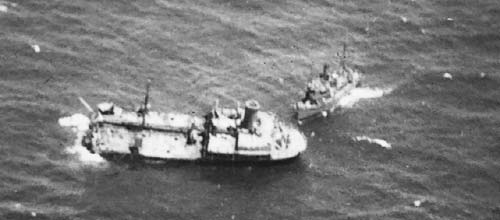 |
|
Fleet tug Umpqua approaches stern of the Naeco (Hickham, Gentile) [BFDC note: It is likely that this is actually a picture of the Esso Nashville as the stern configuration seems to more similar to the profile of that vessel rather than the Naeco.]
|
|
As the Osprey and Umpqua continued their rescue duties, the Dione partnered with the destroyer USS Roper to search for the u-boat which attacked the Naeco. They circled the area several times but had no success. |
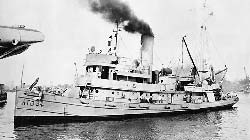 |
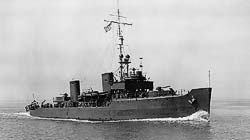 |
| ATO-34 Algorma similar to Umpqua (8) | USS Osprey (AM-56) (6) |
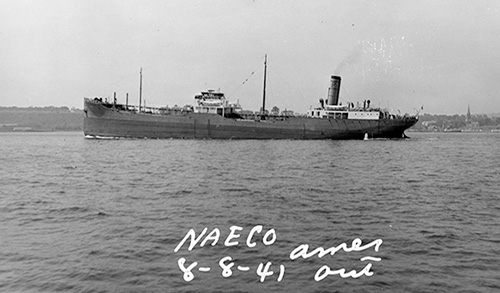 |
|
| Naeco (Mariners Museum via 35) | |
|
|
| DIVING NOTES: |
| Diving Depths: 125-145* ft. Visibility: Generally very good; range 60 to 100+ ft. Current: Slight to moderate Summer Temperature: high 70s to lo 80s Points of Interest: Stern: Boilers, engine, stern anchor, rudder/steering quadrant; Bow: port anchor; bow point Fish/Animal Life: Both sections have large variety of tropical fish; large schools of baitfish are more prevelent on stern; african pampano, amberjack, grouper, sandtiger sharks. In 2000, the stern section of the Naeco was location of the first sightings of the invasive pacific species lionfish in North Carolina waters. It is now quite common in the area Description: The bow and the stern sections of the Naeco sank a couple of miles apart. It was apparent to those who dived the wreck that there was a piece missing - the pilot house area. Was it completely destroyed or did its remains lay somewhere in the sand between the two end sections? After a many year search, Bobby Edwards of the Atlantis IV, discovered the "missing" section. In the end, there are three different places to dive the Naeco. The stern section is the largest, has the highest relief and most often visited. It is lying on its keel and is contiguous. Although the water is generally very clear and the stern section is not too spread out, in my early days of diving I would find myself having to be careful or else I would get turned around in the large schools of baitfish and red-eyes that can sometimes surround a diver - particularly in the flat debris area forward of the high stern section. Once you see that section a couple of times without fish, it is pretty easy to navigate and it is much smaller than it first appears. Once familiar with the stern section, you can easily circumnavigate during a dive. The steering quadrant, the engines and boilers and the deck wall which separates the engine area from the huge tank sections offer the most relief on this portion of the wreck. Forward of this "wall", the stern flattens out and eventually disappears into the sand. *In the early days of diving the Naeco stern, when things were less collapsed, you could find deep sections "inside" the wreck - to 145 ft. I don't think that is possible anymore, though one should always be careful if you start poking around holes and washouts. You can have a very comfortable tour of the stern section without getting much deeper than 120-125 ft...or even shallower if you stay up high. The bow is much smaller and lying flat and nearly collapsed on its starboard side. The port anchor is visible, still sitting in the hawse pipe. I have only been on this section 2-3 times. There is not much notable relief on the bow and that has caused me navigation issues when the fish are locked in there and very thick. The middle "pilot" house section is the smallest section of the three. I have dived it one time and is only visited on special occasions as the location numbers are closely held. A 6-pack dive boat is a somewhat crowded dive on this section. |
|
|
PHOTOS: |
||||
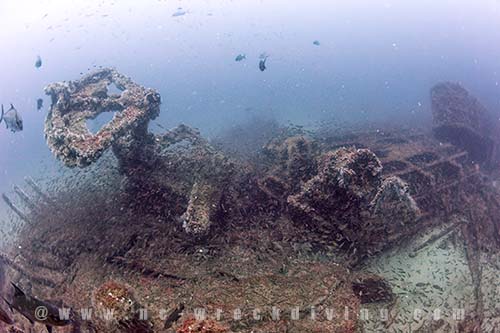
|
||||
| Overview of the stern from the fantail remains (L) to the engine (R) | ||||
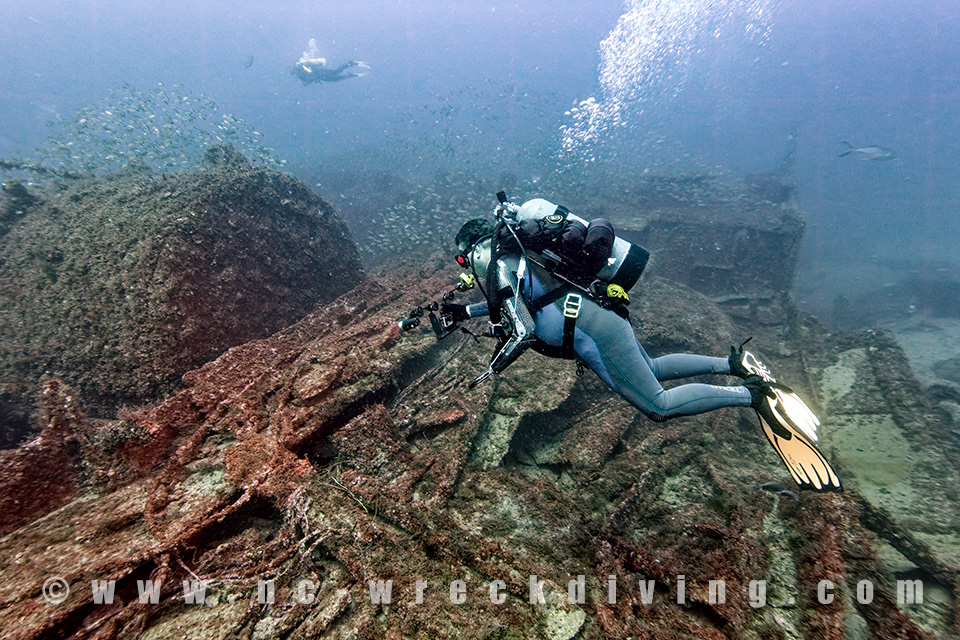
|
||||
| Diver exploring the area around the Naeco boilers | ||||
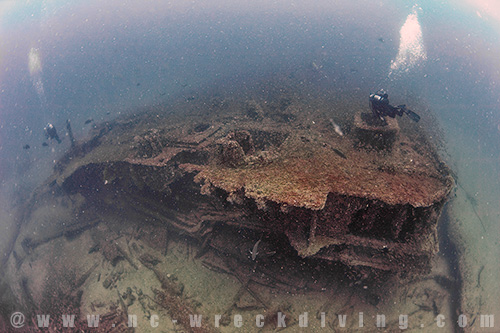
|
||||
| The "break" where the stern of the Naeco broke off of the remainder of the vessel | ||||
 |
||||
| Aft facing end of the engine | ||||
 |
 |
|||
| Steering quadrant on stern | Diver at the stern break | |||
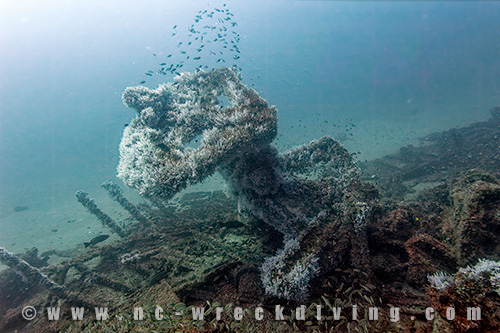 |
||||
| At various times during the year, the steering quadrant "blossoms" with a covering of white soft corals which are alive with tiny fish and other marine life | ||||
 |
 |
|||
| Bow port anchor in hawse pipe | Bow anchor windlass | |||
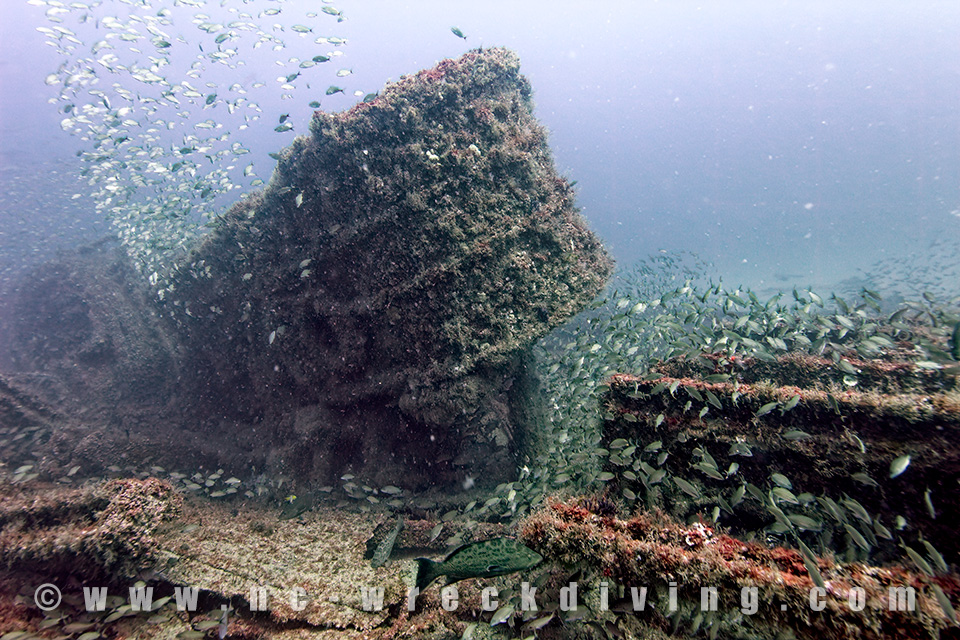 |
||||
| Engine view (circa 2016) | ||||

|
||||
| Diver swims near steering quadrant at the remains of the stern fantail | ||||
 |
 |
|||
| Typical wreck vista forward of the stern break | A spare anchor sits in the wreckage at stern | |||
 |
||||
|
Diver swims along port edge of wreck, besides engine, towards the stern break |
||||
Unless specifically noted, all photos, text and content Copyright © Paul M. Hudy

